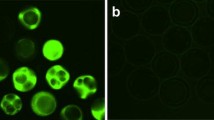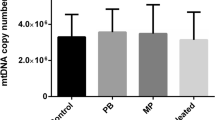Abstract
The effect of DNA microinjection at various times afterin vitro insemination on DNA detection and survival rates of bovine embryos was investigated. Oocytes were inseminated 24 h after maturation with frozen/thawed semen prepared with a Percoll separation procedure. At 11, 15 and 19 h after insemination, embryos were centrifuged to visualize pronuclei and microinjected with a murine whey acidic protein-human protein C genomic DNA construct. After culture for 7 days on Buffalo Rat Liver cells, embryos were assessed for stage of development and assayed for the presence of the transgene by polymerase chain reaction. Of zygotes in the 11h after insemination treatment, 16% (25/152) of non-injected and 7% (11/161) of injected embryos developed to the morula or blastocyst stage. Comparable development of non-injected and injected embryos treated at 15h after insemination was 15% (23/158) and 4% (6/159) and treated at 19 h after insemination was 14% (23/162) and 1% (1/165), respectively. Development of injected embryos was greater (p<0.05) when injection was performed at 11 h after insemination compared to 19 h after insemination. Development of non-injected embryos was greater (p<0.01) than that of injected embryos. There was no difference in transgene detection frequency in embryos of all developmental states between treatments (53% at 11; 50% at 15; 48% at 19h after insemination). Injected embryos testing positive for the presence of the transgene exhibited increased development over negative embryos (p<0.01). Greater development efficiencies can be obtained in microinjected bovine embryos when injection is performed early in pronuclear formation.
Similar content being viewed by others
References
Bavister, B.D. and Yanagimachi, R. (1977) The effects of sperm extracts and energy sources on the motility and acrosome reaction of hamster spermatozoain vitro.Biol. Reprod. 16, 228–37.
Bedford, J.M. (1982) Fertilization. In: Austin, C.R. and Short, R.V. eds,Reproduction in Mammals 1: Germ cells and Fertilization, p. 156. Cambridge, UK: Cambridge University Press. pp. 128–63.
Bialy, H. (1991) Transgenic pharming comes of age.Bio/Technology 9, 786.
Bishop, J.O. and Smith, P. (1989) Mechanism of chromosomal integration of microinjected DNA.Mol. Biol. Med. 6, 283–98.
Bondioli, K.R., Biery, K.A., Hill, K.G., Jones, K.B. and DeMayo, F.J. (1988) Production of transgenic cattle by pronuclear injection. In: First, N.L., and Haseltine, F.P. eds,Transgenic Animals pp. 265–273. Boston: Butterworth-Heinemann.
Brinster, R.L., Chen, H.Y., Trumbauer, M.E., Yagle, M.K. and Palmiter, R.D. (1985) Factors affecting the efficiency of introducing foreign DNA into mice by microinjecting eggs.Proc. Natl Acad. Sci. USA 82, 4438–42.
Browder, L.W., Erickson, C.A. and Jeffery, W.R. (Eds) (1991) Fertilization: the activation of development. In:Developmental Biology, 3rd Edition p. 142. Orlando, FL: Holt, Reinhart and Winston, Inc.
Burdon, T.G. and Wall, R.J. (1992) Fate of microinjected genes in preimplantation mouse embryos.Mol. Reprod. Dev. 33, 436–42.
Canseco, R.S., Sparks, A.E.T., Page, R.L., Russell, C.G., Johnson, J.L., Velander, W.H., Pearson, R.E., Drohan, W.N. and Gwazdauskas, F.C. (1994) Gene transfer efficiency during gestation and the influence of co-transfer of non-manipulated embryos on production of transgenic mice.Transgenic Res. 3, 20–25.
Eyestone, W.H., Leibfried-Rutledge, M.L., Northey, D.L., Gilligan, B.G. and First, N.L. (1987) Culture of one and two cell bovine embryos to the blastocyst stage in the ovine oviduct.Theriogenology 28, 1–7.
Gagne, M., Pothier, F. and Sirard, M.A. (1990) Developmental potential of early bovine zygotes submitted to centrifugation and microinjection followingin vitro maturation of oocytes.Theriogenology 34, 417–25.
Gordon, K., Lee, E., Vitale, S.A., Smith, A.E., Westphal, H. and Henninghausen, L. (1987) Production of human tissue plasminogen activator in transgenic mouse milk. Bio/Technology5, 1183–7.
Hill, K.G., Curry, J., DeMayo, F.J., Jones-Diller, K., Slapak, J.R. and Bondioli, K.R. (1992) Production of transgenic cattle by pronuclear injection.Theriogenology 37, 222.
Jänne, J., Hyttinen, J.-M., Peura, T., Tolvanen, M., Alhohen, L. and Halmekytö, M. (1992) Transgenic animals as bioproducers of therapeutic proteins.Ann. Med. 24, 273–80.
Krimpenfort, P., Rademakers, A., Eyestone, W., van der Schans, A.S., van den Broek, S., Kooiman, P., Kootwijk, E., Platenburg, G., Pieper, F., Strijker, R. and de Boer, H. (1991) Generation of transgenic dairy cattle usingin vitro embryo production. Bio/Technology9, 844–7.
Lewis-Williams, J., Houseal, T., Harvey, M., DiTullio, P. and Ziomek, C. (1993) Selection of preimplantation mouse embryos using fluorescencein situ hybridization.Theriogenology 39, 258.
McLaren, A. (1992) The embryo. In: Austin, C.R. and Short, R.V. eds,Reproduction in Mammals 2: Embryonic and Fetal Development, p 3. Cambridge: Cambridge University Press.
Mermillod, P., Wils, C., Massip, A. and Dessy, F. (1992) Collection of oocytes and production of blastocystsin vitro from individual, slaughtered cows.J. Reprod. Fertil. 96, 717–23.
Powell, D.J., Galli, C. and Moor, R.M. (1992) The fate of DNA injected into mammalian oocytes and zygotes at different stages of the cell cycle.J. Reprod. Fertil. 95, 211–20.
Saeki, K., Kato, H., Hosoi, Y., Miyake, M., Utsumi, K. and Iritani, I. (1991) Early morphological events inin vitro fertilized bovine oocytes with frozen thawed spermatozoa.Theriogenology 35, 1051–8.
Saiki, R.K., Walsh, P.S., Levenson, C.H. and Ehrlich, H.A. (1989) Genetic analysis of amplified DNA with immobilized sequence-specific oligonucleotide probes.Proc. Natl. Acad. Sci. USA 86, 6230–4.
SAS Institute, Inc. (1985) SAS User's Guide: Statistics. Cary, NC, USA.
Simons, J., McClenaghan, M. and Clark, A. (1987) Alteration of the quality of milk expression of β-lactoglobulin in transgenic mice.Nature 328, 530–2.
Thomas, W.K., Schnieke, A. and Seidel, G.E., Jr. (1993) Methods for producing transgenic bovine embryos fromin vitro matured and fertilized oocytes.Theriogenology 40, 679–88.
Velander, W.H., Johnson, J.L., Page, R.L., Russell, C.G., Subramanian, A., Wilkins, T.D., Gwazdauskas, F.C., Pittius, C. and Drohan, W.N. (1992) High-level expression of a heterologous protein in the milk of transgenic swine using the cDNA encoding human protein C.Proc. Natl Acad. Sci. USA 89, 12003–7.
Voelkel, S.A. and Hu, Y.X. (1992) Effect of gas atmosphere on the development of one-cell bovine embryos in two culture systems.Theriogenology 37, 1117–31.
Wall, R.J., Pursel, V.G., Shamay, A., McKnight, R.A., Pittius, C.W. and Hennighausen, L. (1991) High-level synthesis of a heterologous milk protein in the mammary glands of transgenic swine.Proc. Natl Acad. Sci. USA 88, 1696–700.
Watson, J.D., Tooze, J. and Kurtz, D.T. (1983) The introduction of foreign genes into fertilized mouse eggs. In: Recombinant DNA; a Short Course, p. 210. New York, Scientific American Books.
Whitelaw, C.B.A., Springbett, A.J., Webster, J. and Clark, J. (1993) The majority of G0 transgenic mice are derived from mosaic embryos.Transgenic Res. 2, 29–32.
Williams, B.L., Sparks, A.E.T., Canseco, R.S., Knight, J.W., Johnson, J.L., Velander, W.H., Page, R.L., Drohan, W.N., Young, J.M., Pearson, R.E., Wilkins, T.D. and Gwazdauskas, F.C. (1992)In vitro development of zygotes from prepubertal gilts after microinjection of DNA.J. Anim. Sci. 70, 2207–11.
Wilmut, I., Hooper, M.L. and Simons, J.P. (1991) Genetic manipulation of mammals and its application in reproductive biology.J. Reprod. Fertil. 92, 245–79.
Xu, K.P. and Greve, T.A. (1988) A detailed analysis of early events during in vitro fertilization of bovine follicular oocytes.J. Reprod. Fertil. 82, 127–34.
Author information
Authors and Affiliations
Rights and permissions
About this article
Cite this article
Krisher, R.L., Gibbons, J.R., Canseco, R.S. et al. Influence of time of gene microinjection on development and DNA detection frequency in bovine embryos. Transgenic Research 3, 226–231 (1994). https://doi.org/10.1007/BF02336775
Received:
Revised:
Accepted:
Issue Date:
DOI: https://doi.org/10.1007/BF02336775




